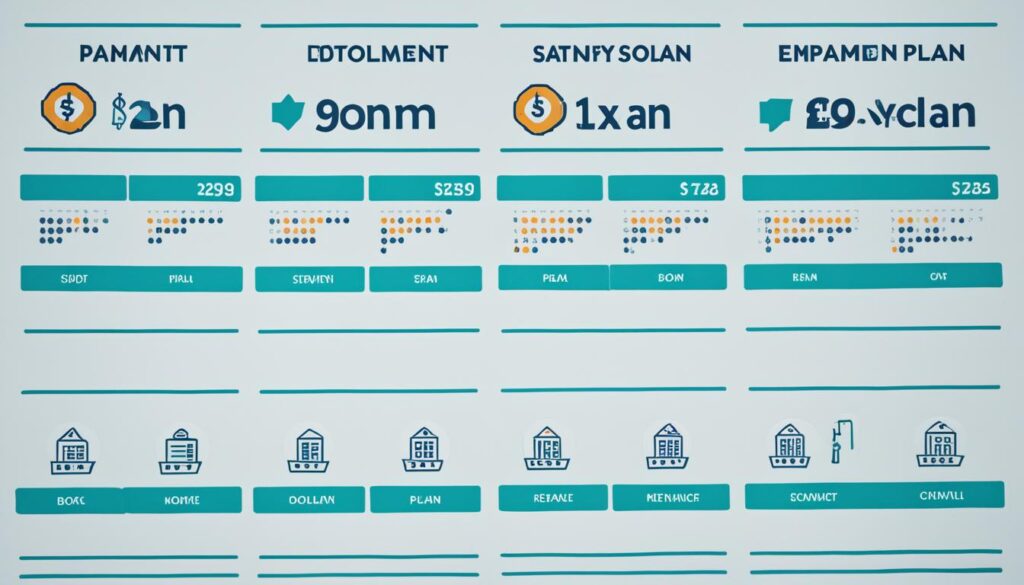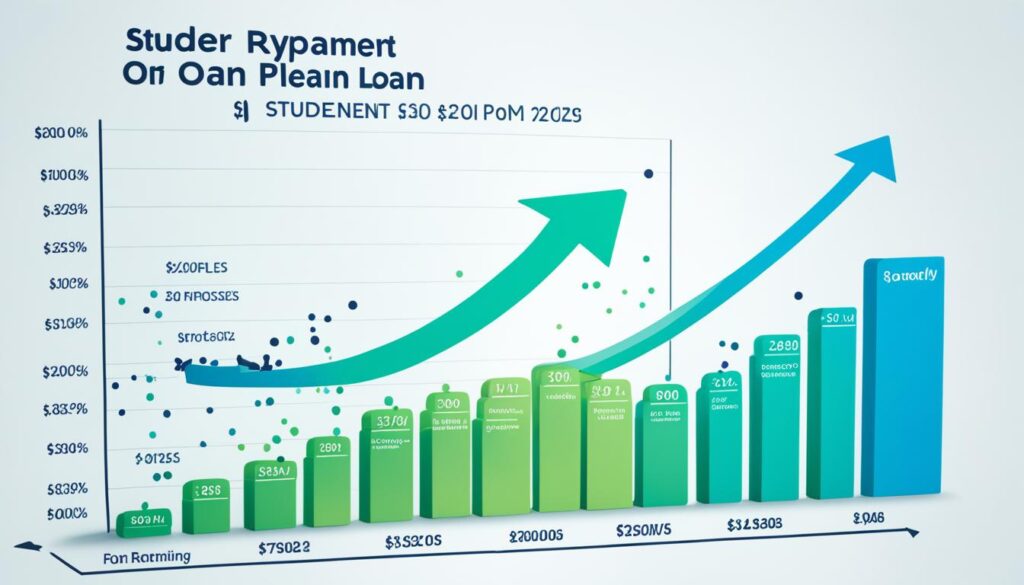Taking out loans for education is a major step in reaching your dreams. But paying them back can seem overwhelming. The good news is, you have several ways to manage your student loan payments. This includes the standard plan and income-based ones for federal loans. We will look into these options. Let’s get started!
Key Takeaways:
- There are four types of federal student loan repayment plans.
- The standard plan and income-driven plans are often best for most people.
- The standard plan is a 10-year method that lets you pay less interest over time.
- Income-driven plans base your payments on your income. They can last for 20 to 25 years.
- Four types of income-based plans exist. We will talk about them more.
Standard Repayment Plan
The standard plan is great for those wanting to pay less interest in the long run. It offers a 10-year term. This lets you clear your debt faster, lowering the overall interest you pay.
With this plan, you pay the same amount each month for ten years. This keeps you on budget and steadily clears your loan without ups and downs.
Choosing this plan can save you money. A 10-year term means interest has less time to build up. So, in the end, you pay less and clear your debt sooner than in other plans.
Moreover, this plan gives you financial peace. Since payments are set, you can plan your budget easily. This helps you focus on other financial goals while managing your student loan debt.

Benefits of the Standard Repayment Plan:
- Paying off loans faster: The 10-year repayment term allows you to become debt-free more quickly.
- Paying less in interest: By reducing the overall repayment period, you can significantly decrease the amount of interest accrued over time.
- Financial predictability: Fixed monthly payments make it easier to plan your budget and manage your expenses.
Remember, the standard plan might not be right for everyone. Make sure it fits your financial situation well. Think about your income and goals before you decide.
| Repayment Plan | Repayment Term | Monthly Payment | Interest Paid |
|---|---|---|---|
| Standard Repayment Plan | 10 years | Fixed | Lower than other plans |
| Income-Driven Repayment Plans | 20 or 25 years | Varies based on income | Potentially higher |
| Graduated Repayment Plan | 10 years | Increases over time | Varies based on income |
| Extended Repayment Plan | 25 years | Fixed or increases over time | Higher due to longer repayment period |
Compare different plans to find what suits you best. Look at how long each takes to pay off, the monthly costs, and how much interest you’ll pay. Choosing wisely can help you manage your debt and plan for a better future.
Income-Driven Repayment Plans
Income-driven repayment plans help those who need lower payments. They may also allow for loan forgiveness. These plans set payments based on how much one can pay.
The payment amount depends on the plan and the borrower’s income. This makes it easier to manage paying back student loans over time.
- Pay As You Earn (PAYE)
- Revised Pay As You Earn (REPAYE)
- Income-Based Repayment (IBR)
- Income-Contingent Repayment (ICR)
There are four types of these plans. Each works slightly differently but all aim to be fair and flexible. They change with your income and make sure you can keep up.
To make this information better for search engines, we’ll mention key terms like lower monthly payments and loan forgiveness. Doing this improves the article without losing its main point.
Graduated Repayment Plan
The graduated repayment plan is perfect for those wanting lower initial payments. These payments increase over time. It allows borrowers to start with low payments and increase them every two years, for up to 10 years.
This choice is great for people expecting to earn more in the future. They can pay off their loans more quickly this way.
With the graduated repayment plan, you start with lower payments. These payments get bigger over time. This option fits well for those looking forward to earning more in the future.
While starting payments are low, the graduated repayment plan can lead to more interest paid. Yet, it’s flexible and a good choice if your income will likely go up.

“The graduated repayment plan is a great option for borrowers who want to start with lower payments but have confidence in their ability to handle increasing payments over time. It allows for more initial flexibility and can be a strategic choice for those with anticipated income growth.”
Tuition Loan Example: Graduated Repayment Plan
| Year | Payment Amount | Total Payments |
|---|---|---|
| Year 1 | $300 | $3,600 |
| Year 2 | $400 | $4,800 |
| Year 3 | $500 | $6,000 |
| Year 4 | $600 | $7,200 |
| Year 5 | $700 | $8,400 |
| Year 6 | $800 | $9,600 |
| Year 7 | $900 | $10,800 |
| Year 8 | $1,000 | $12,000 |
| Year 9 | $1,100 | $13,200 |
| Year 10 | $1,200 | $14,400 |
Let’s use an example to explain how it works. A borrower chooses a graduated repayment plan for their tuition loan. They start paying $300 a month. Then, every year they add $100 to their payment. After 10 years, they are paying back $1,200 each month. In the end, they will have paid $14,400.
Extended Repayment Plan
If you’re looking for a way to pay off your student loans with lower monthly payments, the extended repayment plan might be what you need. This plan allows you to choose between making fixed or graduated payments over a longer time.
If you go for fixed payments, your loan will be spread out evenly over 25 years. You’ll pay the same amount every month. This plan is good if you like to budget with the same amount each month.
On the other hand, you can select graduated payments. These start off lower and then increase every two years. It’s a solid choice if you think you’ll make more money as time goes on. You’ll pay less in the beginning and more later when you can afford it.
While you get the benefit of making smaller payments, it’s important to note that this plan doesn’t forgive your loan. However, it can still work for you if making smaller payments is your main goal. This way, you’ll have more cash to use in your day-to-day expenses.

Pros of the Extended Repayment Plan
- Lower monthly payments
- Flexibility in budgeting
- Option to choose between fixed or graduated payments
Cons of the Extended Repayment Plan
- Longer repayment period
- No loan forgiveness
- More interest paid over time
If you’re thinking about this plan, consider its pros and cons based on your finances and goals. It’s great if you want a low, steady payment. But if getting rid of debt fast or having part of it forgiven is your aim, look into other options like income-driven plans.
Prepaying Loans
Should you prepay your student loans to cut down on interest? Yes, you should. This option works with any repayment plan but is best with the standard plan. When you put extra payments on the principal, you pay less interest over the loan’s life.

“Paying off your student loans ahead of schedule can provide significant financial benefits. It allows you to save on interest expenses and become debt-free sooner,” says Sarah Johnson, a financial advisor.
Prepaying loans can save you a lot on interest. Paying more on the principal early on saves the most. You could save a bunch of money on interest this way.
Let’s look at how prepaying affects interest payments:
| Loan Balance | Interest Rate | Loan Term | Monthly Payment | Total Interest Paid |
|---|---|---|---|---|
| $30,000 | 5% | 10 years | $318 | $5,167 |
| $30,000 | 5% | 10 years (with extra payments) | $500 | $3,403 |
In the example above, an extra $182 per month can lessen interest by more than $1,700.
Make sure to direct extra payments to the loan principal. This way, you pay less interest in total. It’s about reducing the loan’s remaining balance.
Prepaying your loans means you need to budget and plan well. Think about your financial goals and make sure you have enough for daily life and emergencies.
By prepaying, you cut down interest and can be debt-free faster. It’s a smart move for taking charge of your financial well-being. Achieving your financial dreams becomes easier this way.
Temporary Pause in Payments
People with money problems may want to stop paying their student loans for a while. Luckily, there are ways to get help. You can either defer your payments or go into forbearance for a bit.
Deferment lets you stop paying back your loan for a while. Your loan won’t gather more debt if it’s a subsidized one. But if it’s not, you might end up owing more because the interest keeps adding up.
Forbearance is similar but different. It still means you can stop paying for a bit. Yet, every loan will get more expensive during this time. This includes loans with and without interest added during school.
Instead of deferment or forbearance, you can look into a different plan if you’re struggling. With some plans, you could pay as little as $0. These payments also count towards getting your loan forgiven over time.
Types of Temporary Payment Pause:
- Deferment: Postpones repayment, some loans may accrue interest
- Forbearance: Temporarily pauses payments, all loans accrue interest
Before choosing to stop paying your loan, really think about what’s best for you. While not paying for a bit helps in the short run, it might make your loan bigger in the long run. Looking into different repayment plans might give you a better way to handle things.
| Option | What Happens to Payments? | Does Interest Accrue? |
|---|---|---|
| Deferment | Postponed | Some loans may accrue interest |
| Forbearance | Paused | All loans accrue interest |
Public Service Loan Forgiveness
Public Service Loan Forgiveness (PSLF) helps borrowers by forgiving their student loans. They just need to work for the government, public schools, or some non-profits. It’s a way to reward those in public service and manage their student debts.
Borrowers qualify for PSLF by making 120 loan payments. These payments are under a specific plan tied to their income. After ten years of service in public roles, the program forgives the remaining loan amount.
Signing up for an income-driven plan is key for those eyeing PSLF. This plan makes monthly payments lower based on income. It ensures these payments count towards the 120 needed for loan forgiveness.
How to Qualify for Public Service Loan Forgiveness:
- Work full-time for a qualifying employer, such as a government agency, public school, or eligible nonprofit organization.
- Make 120 qualifying loan payments under a specific plan.
- Use loans from the federal direct loan program only.
Not all federal student loans can get PSLF. Loans from the Direct Loan Program qualify, not from FFEL or Perkins. If you have those, you may need to combine them into a Direct Consolidation Loan.
If you work in public service and have federal loans, PSLF is worth looking into. It offers a way to lessen your debt over time. Meeting the employer and payment requirements leads to loan forgiveness.
Disclaimer: The image above introduces the Public Service Loan Forgiveness program visually. Its purpose is illustrative only.
Private Student Loans
Federal student loans offer many repayment options, while private loans have fewer. Still, private loan borrowers can choose from various repayment plans. These include options like immediate repayment and interest-only payments.
• Immediate Repayment: Under this option, borrowers start making full principal and interest payments immediately after loan disbursement. This can help save on interest payments over the life of the loan.
• Interest-Only Payments: With this plan, borrowers make monthly payments that cover only the loan’s interest charges. While the loan balance won’t decrease, it can ease short-term financial burdens.
• Fixed Payments: This option involves making equal payments each month. It helps with budgeting since the payment amount remains steady.
• Full Deferment: This option postpones all payments until after graduation. Yet, interest keeps building up during this period.
Having private loans means you should talk to your lender about your repayment options. They can explain the plans they have and help you find the best one for your finances.
Refinancing Private Student Loans
If you have a good credit score and a steady income, consider refinancing. Refinancing means getting a new loan with a lower interest rate. This process can reduce your costs over time.
Refinancing lets you do a few things:
- Combine several loans into one for simpler management.
- Get a lower interest rate if your credit score has gone up.
- Pick a new repayment term that works with your budget and goals.
When refinancing, be sure to look at all the new loan’s terms. Some lenders charge fees or might ask for a cosigner. And if you refinance federal loans, you might lose benefits like income-driven plans or loan forgiveness.
Private Student Loan Repayment Options
| Repayment Option | Description |
|---|---|
| Immediate Repayment | Borrowers start making full principal and interest payments immediately after loan disbursement. |
| Interest-Only Payments | Borrowers make monthly payments covering only the interest accruing on the loan. |
| Fixed Payments | Borrowers make equal monthly payments over the term of the loan. |
| Full Deferment | Borrowers can postpone all payments until after graduation, but interest may continue to accrue. |
Source: [Lender Name]
Though private loans have fewer repayment options than federal ones, there are still ways to find a good plan with your lender’s help. Also, check out refinancing as it could lead to lower rates and more savings over time.
Eligibility and Enrollment
When looking at federal student loan repayment plans, understanding who can apply is crucial. To be eligible, it depends on the loan type, how much you earn, and your family’s size.
To get on a federal student loan repayment plan, there are two main ways:
- Calling your loan servicer
- Visiting the Federal Student Aid website
Your loan servicer is there to help you pick the best plan with advice just for you. Or, you can use the Federal Student Aid website. It’s a great place to look at and choose plans online.
Before you apply, make sure you check if you meet the rules for each repayment plan. The rules differ based on your loan and might look at how much you make and your family’s size.
Knowing who can sign up and picking the right way to apply helps ensure you smoothly join a student loan repayment plan that meets your financial needs and aims.
Considerations for Parent PLUS Loans
Parent PLUS loans have unique repayment options. They’re not initially open to income-driven plans. But, you can make them eligible by consolidating into a Direct Consolidation Loan.
By consolidating, you can access income-driven plans. For many, this offers a way to lower monthly payments based on income. This can make managing finances easier.
Besides, borrowers can try the extended or graduated plans. These may lower monthly costs by stretching out the term or starting with smaller payments that increase over time.
It’s important to look closely at all the choices. This means comparing and understanding each plan’s terms. This simple step can really help in making payments more manageable.
And remember, if consolidation doesn’t fit your needs or if you’re unsure about your loans, talk to your loan servicer. They can offer personalized advice that fits your specific situation.
Conclusion
When picking a student loan payback plan, think about your money, income, loan amount, and aims. For those who can manage it, the standard plan is great. It lets you finish your loans quicker and pays less in interest.
But, if money’s tight, consider an income-driven plan. It offers lower monthly payments and even loan forgiveness for some. This makes it a good choice for those not earning much.
If you have private student loans, check what options your lender offers. Also, think about refinancing. It can be smart if you’ve got good credit. Refinancing might mean lower interest and saving on total costs.
Finally, the best payback option fits your financial aims and life. Look closely at each plan’s pros and cons. This way, you can deal with your student debt smartly and head towards financial freedom.
FAQ
What are the best student loan repayment options?
For most, the top choices are the standard and income-driven plans. Everyone’s situation is unique, so it varies.
What is the standard repayment plan?
This plan lasts 10 years with equal monthly payments. It’s great for paying less interest over time.
What are income-driven repayment plans?
These plans link payments to income, lasting 20 or 25 years. Four options exist, including PAYE, REPAYE, IBR, and ICR.
What is the graduated repayment plan?
It starts with low payments that increase every two years for a decade. It helps those expecting an income rise pay off loans quickly.
What is the extended repayment plan?
Offering lower payments over more years, it has two forms. One spreads payments equally over 25 years, the other starts low and increases over time.
Can I prepay my student loans?
Yes. Prepaying can lower interest. It’s especially impactful with the standard plan. Extra payments towards the principal lower the total interest paid.
What options are available for temporarily pausing student loan payments?
Deferment and forbearance allow pausing payments. But, income-driven plans reduce payments to as low as
FAQ
What are the best student loan repayment options?
For most, the top choices are the standard and income-driven plans. Everyone’s situation is unique, so it varies.
What is the standard repayment plan?
This plan lasts 10 years with equal monthly payments. It’s great for paying less interest over time.
What are income-driven repayment plans?
These plans link payments to income, lasting 20 or 25 years. Four options exist, including PAYE, REPAYE, IBR, and ICR.
What is the graduated repayment plan?
It starts with low payments that increase every two years for a decade. It helps those expecting an income rise pay off loans quickly.
What is the extended repayment plan?
Offering lower payments over more years, it has two forms. One spreads payments equally over 25 years, the other starts low and increases over time.
Can I prepay my student loans?
Yes. Prepaying can lower interest. It’s especially impactful with the standard plan. Extra payments towards the principal lower the total interest paid.
What options are available for temporarily pausing student loan payments?
Deferment and forbearance allow pausing payments. But, income-driven plans reduce payments to as low as $0, which can help reach forgiveness.
What is Public Service Loan Forgiveness?
It offers loan forgiveness after 120 payments in public service jobs. Qualification often involves an income-driven or standard plan.
What repayment options are available for private student loans?
Private loans have fewer options. They might include immediate payments, interest-only, fixed payments, or deferment. Borrowers should discuss options with their lender. Refinancing can be good with a high credit score, possibly reducing interest costs.
How do I determine my eligibility for federal student loan repayment plans?
Your loan type, income, and family size affect eligibility. Check with your loan servicer or the Federal Student Aid website for more. Knowing plan details is vital before applying.
What considerations should I keep in mind for Parent PLUS loans?
Parent PLUS loans have different rules. Unless consolidated into a Direct Consolidation Loan, they aren’t for income-driven plans. Exploring other plans for lower payments is advised based on your situation.
Are there any other factors to consider when choosing a repayment option?
Think about your finances, income, balance, and goals. For some, the standard plan is most affordable. Others benefit from income-driven plans. Private loan borrowers should check with lenders. Refinancing might save money. Choose a plan that fits your financial goals.
, which can help reach forgiveness.
What is Public Service Loan Forgiveness?
It offers loan forgiveness after 120 payments in public service jobs. Qualification often involves an income-driven or standard plan.
What repayment options are available for private student loans?
Private loans have fewer options. They might include immediate payments, interest-only, fixed payments, or deferment. Borrowers should discuss options with their lender. Refinancing can be good with a high credit score, possibly reducing interest costs.
How do I determine my eligibility for federal student loan repayment plans?
Your loan type, income, and family size affect eligibility. Check with your loan servicer or the Federal Student Aid website for more. Knowing plan details is vital before applying.
What considerations should I keep in mind for Parent PLUS loans?
Parent PLUS loans have different rules. Unless consolidated into a Direct Consolidation Loan, they aren’t for income-driven plans. Exploring other plans for lower payments is advised based on your situation.
Are there any other factors to consider when choosing a repayment option?
Think about your finances, income, balance, and goals. For some, the standard plan is most affordable. Others benefit from income-driven plans. Private loan borrowers should check with lenders. Refinancing might save money. Choose a plan that fits your financial goals.



















